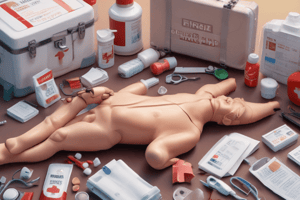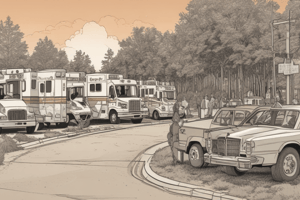Podcast
Questions and Answers
What should be performed during the initial patient assessment to form a general impression?
What should be performed during the initial patient assessment to form a general impression?
- Conduct a thorough physical examination
- Request additional resources
- Conduct a primary survey (correct)
- Begin invasive medical interventions
What is a common presentation of a pneumothorax?
What is a common presentation of a pneumothorax?
- Numbness in the extremities
- Abnormal heart rate
- Loss of consciousness
- Sudden sharp chest pain (correct)
What is the most common injury resulting from blunt thoracic trauma?
What is the most common injury resulting from blunt thoracic trauma?
- Hemothorax
- Rib fractures
- Flail chest
- Pulmonary contusion (correct)
What is a characteristic of commotio cordis?
What is a characteristic of commotio cordis?
What is a common cause of cardiac tamponade?
What is a common cause of cardiac tamponade?
What is a characteristic of traumatic asphyxia?
What is a characteristic of traumatic asphyxia?
What is the primary goal of the initial patient assessment?
What is the primary goal of the initial patient assessment?
What is a common presentation of a hemothorax?
What is a common presentation of a hemothorax?
What is a characteristic of a flail chest?
What is a characteristic of a flail chest?
What is a common cause of traumatic aortic disruption?
What is a common cause of traumatic aortic disruption?
Flashcards are hidden until you start studying
Study Notes
Initial Patient Assessment
- Perform scene size-up to identify the number of patients and request additional resources as needed
- Conduct a primary survey to form a general impression and note the patient's level of consciousness
- Rapidly examine for obvious injuries, such as:
- Difficulty breathing
- Noisy or irregular breathing
- Asymmetrical chest rise
- Accessory muscle use
- External jugular vein distension
- Identify life threats and protect the spine as early as possible
Respiratory Assessment
- Examine the neck for penetrating wounds and tracheal position
- Determine if breathing is present and adequate
- Expect equal expansion of the chest wall and look for:
- Retractions
- Puncture wounds
- Open chest injuries
- Absent or decreased breath sounds on one side indicate significant lung damage
Chest Injuries
- Rib fractures:
- Most frequent in older patients
- Increase mortality rate with age and number of fractures
- May lacerate the lung, causing subcutaneous emphysema
- Flail chest:
- Segment of the chest wall detached from the rest of the thoracic cage
- Produces a free-floating segment
- Often caused by MVCs, Falls, or industrial accidents
- Mortality rate increases with age and number of associated injuries
- Sternal fractures:
- Isolated fractures have a high mortality rate
- Increase mortality rate with age and additional injuries
- Clavicular fractures:
- Most common in children
- Often caused by Falls or crushing injuries
- Patients may report pain in the shoulder and hold the arm across the front of the body
Cardiac Arrest
- Commotio cordis:
- A direct blow to the chest during the critical portion of the heart's repolarization phase
- Leads to immediate cardiac arrest
- Survival rate depends on public awareness, CPR, and AED access
Pneumothorax
- Occurs when air enters the plural space through a hole in the chest wall or surface of the lung
- Presentation:
- Sudden sharp chest pain
- Shortness of breath
- Decreased breath sounds
- Hyperresonance on percussion
- Tension pneumothorax:
- Pressure builds up in the plural space
- Collapse of the affected lung
- Shift of the mediastinum
- Decreased breath sounds, pulseless paradoxus, and Taria
Hemothorax
- Accumulation of blood in the plural space
- Causes:
- Tears
- Penetrating wounds
- Blunt trauma
- Deceleration shearing of major vessels
- Presentation:
- Decreased breath sounds
- Hypovolemia
- Shock
- Dullness on percussion
- Flat or distended neck veins
Pulmonary Contusion
- Most common injury from blunt thoracic trauma
- Often associated with rib fractures
- Causes:
- Implosion effect
- Inertial effect
- Spalling effect
- Presentation:
- Respiratory distress
- Hypoxia
- Carbon dioxide retention
- Wheezes, rhonchi, or crackles
- Diminished breath sounds
Cardiac Tamponade
- Collection of blood or fluid in the paricardium
- Prevents the heart from filling completely during diastole
- Causes:
- Penetrating injuries
- Blunt trauma
- Presentation:
- Narrowing pulse pressure
- JVD
- Muffled heart tones
- Hypotension
- Hypovolemia
Traumatic Aortic Disruption
- Rupture of the aorta
- Causes:
- Blunt trauma
- MVCs
- Falls
- Presentation:
- Retrosternal or interscapular pain
- Dyspnea
- Dysphagia
- Hoeness
- Strider
- Upper extremity hypertension
- Absent or decreased femoral pulses### Traumatic Asphyxia
- Caused by sudden severe compression injury to the chest, producing rapid increase in thoracic pressure
- Force squeezes the chest, causing blood to back up into the head and neck
- Leads to jugular veins engorgement and capillaries rupture
Characteristic Appearance
- Distended neck veins
- Cyanosis in the face and upper neck and extremities
- Swelling and cyanosis of the tongue and lips
- Ocular hemorrhage (mild or extreme)
- Skin below the area of compression remains normal in color
Key Features and Management
- Hypotension occurs when pressure is released
- Early recognition and rapid transport are crucial
- Treat symptoms with cervical spinal precautions
- Obtain IV access with two large bore IVs
Initial Patient Assessment
- Initial assessment should include a scene size-up to identify the number of patients and request additional resources if needed
- Conduct a primary survey to form a general impression and note the patient's level of consciousness
- Identify life threats and protect the spine as early as possible
Respiratory Assessment
- Examine the neck for penetrating wounds and tracheal position
- Determine if breathing is present and adequate
- Check for equal expansion of the chest wall and look for signs of respiratory distress, such as retractions, puncture wounds, or open chest injuries
- Absent or decreased breath sounds on one side may indicate significant lung damage
Chest Injuries
- Rib fractures are more common in older patients and increase mortality rate with age and number of fractures
- Flail chest occurs when a segment of the chest wall is detached from the rest of the thoracic cage, often caused by MVCs, Falls, or industrial accidents
- Sternal fractures have a high mortality rate, especially with age and additional injuries
- Clavicular fractures are most common in children, often caused by Falls or crushing injuries
Cardiac Arrest
- Commotio cordis is a direct blow to the chest during the critical portion of the heart's repolarization phase, leading to immediate cardiac arrest
- Survival rate depends on public awareness, CPR, and AED access
Pneumothorax
- Occurs when air enters the plural space through a hole in the chest wall or surface of the lung
- Symptoms include sudden sharp chest pain, shortness of breath, decreased breath sounds, and hyperresonance on percussion
- Tension pneumothorax can lead to collapse of the affected lung, shift of the mediastinum, and decreased breath sounds, pulseless paradoxus, and Taria
Hemothorax
- Accumulation of blood in the plural space, often caused by tears, penetrating wounds, blunt trauma, or deceleration shearing of major vessels
- Symptoms include decreased breath sounds, hypovolemia, shock, dullness on percussion, and flat or distended neck veins
Pulmonary Contusion
- Most common injury from blunt thoracic trauma, often associated with rib fractures
- Caused by implosion, inertial, or spalling effects
- Symptoms include respiratory distress, hypoxia, carbon dioxide retention, wheezes, rhonchi, or crackles, and diminished breath sounds
Cardiac Tamponade
- Collection of blood or fluid in the pericardium, preventing the heart from filling completely during diastole
- Caused by penetrating injuries or blunt trauma
- Symptoms include narrowing pulse pressure, JVD, muffled heart tones, hypotension, and hypovolemia
Traumatic Aortic Disruption
- Rupture of the aorta, often caused by blunt trauma, MVCs, or Falls
- Symptoms include retrosternal or interscapular pain, dyspnea, dysphagia, hoarseness, strider, upper extremity hypertension, and absent or decreased femoral pulses
Traumatic Asphyxia
- Caused by sudden severe compression injury to the chest, producing rapid increase in thoracic pressure
- Symptoms include distended neck veins, cyanosis in the face and upper neck and extremities, swelling and cyanosis of the tongue and lips, ocular hemorrhage, and skin below the area of compression remains normal in color
- Hypotension occurs when pressure is released, and early recognition and rapid transport are crucial
Studying That Suits You
Use AI to generate personalized quizzes and flashcards to suit your learning preferences.




